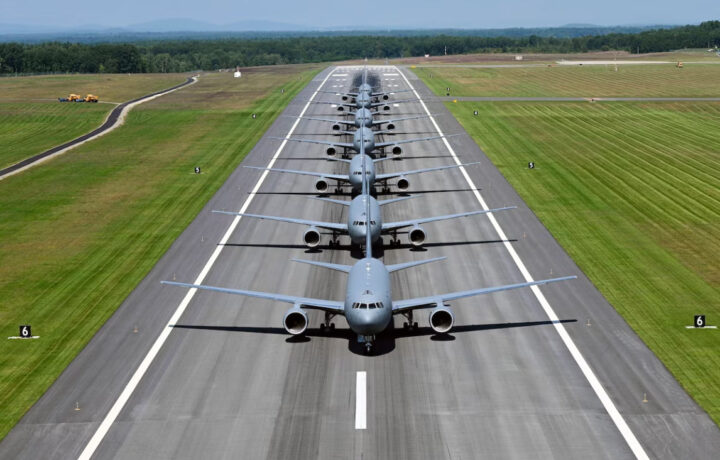Beginning as early as next week, the United States Air Force could resume accepting the Boeing KC-46 aerial refueling and strategic military transport aircraft, which is based on the 767 jet airliner. Deliveries were halted in February after the service discovered cracks in the “outboard fixed fixed-trailing-edge support structure.” The aerospace giant announced that it had identified the root cause of the issues, and has begun the process to resume deliveries.
“We understand the KC-46A’s importance to the Air Force’s mission and its role in delivering advanced tanking capabilities. We look forward to continuing our work together to grow and sustain the fleet,” Lynn Fox, vice president and KC-46 program manager, said in a statement.
Though the delivery of the aircraft has been paused, Boeing has said the cracks were not a safety flight concern, but it acknowledged it needed to be addressed.
According to a report from Breaking Defense, the Air Force’s fleet of 89 KC-46s had been inspected, with cracks discovered on 21 of the aircraft. Repairs had been completed on all but three, while the issues will be addressed on all the planes.
Remote Vision Problems Persist
The Pegasus could return to the skies, yet another issue will remain unresolved. The refueling tanker’s remote vision system (RVS), which provides images to boom operators in the aircraft’s two Aerial Refueling Operator Stations (AROS), has been delayed again.
The upgrade is already a year behind schedule, and the RVS 2.0 may not be employed on the refueling aircraft until summer 2027. The RVS promised to be a major improvement from older tankers, including the KC-10 Extender and KC-135 Stratotanker, which required the boom operators to look through a window in the rear of the aircraft. In the case of the KC-135, boom operators even have to lie on their stomachs while carrying out the operation.
The KC-46 was meant to place the boom operators in stations in the front of the tanker, but the RVS has faced numerous problems, including distorted images. The RVS 2.0, which will employ more advanced sensors, screens, and even a 4K ultrahigh-definition camera that can produce a 3D, full-color image, was meant to address the shortcomings.
A High-Tech Flying Gas Station
Despite the ongoing “teething” problems, the KC-46A Pegasus has been touted as a significant improvement for the Air Force. Even with the issues, experienced boom operators have said it has major advantages over the older aircraft.
In early 2011, the KC-46 was selected by the U.S. Air Force as the winner of its KC-X tanker competition, with Boeing awarded a contract to replace the aging KC-135s. The first Pegasus was delivered to the air service in January 2019. Last November, Boeing was also awarded a Lot 11 contract, valued at $2.38 billion, to build an additional 15 of the multi-mission and airlift aircraft for the U.S. Air Force. That will bring the total number of aircraft to 168.
“We appreciate our continued partnership with the U.S. Air Force,” Fox said at the time the contract was awarded. “This is another big milestone for our team, and we look forward to delivering the world’s most advanced multi-mission aerial refuelers for years to come.”
To date, the Pegasus has accumulated more than 100,000 flight hours while it has offloaded more than 200 million pounds of fuel, according to Airforce-Techonology.com.
The KC-46A is able to refuel most fixed-wing, receiver-capable aircraft. It can also accommodate a mixed load of passengers, aeromedical evacuation and cargo capabilities.




